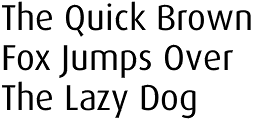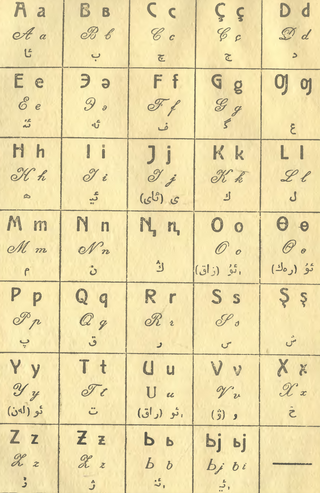
A diacritic is a glyph added to a letter or to a basic glyph. The term derives from the Ancient Greek διακριτικός, from διακρίνω. The word diacritic is a noun, though it is sometimes used in an attributive sense, whereas diacritical is only an adjective. Some diacritics, such as the acute ⟨ó⟩, grave ⟨ò⟩, and circumflex ⟨ô⟩, are often called accents. Diacritics may appear above or below a letter or in some other position such as within the letter or between two letters.
A pangram or holoalphabetic sentence is a sentence using every letter of a given alphabet at least once. Pangrams have been used to display typefaces, test equipment, and develop skills in handwriting, calligraphy, and typing.
The Hungarian alphabet is an extension of the Latin alphabet used for writing the Hungarian language.
The Balinese script, natively known as Aksarä Bali and Hanacaraka, is an abugida used in the island of Bali, Indonesia, commonly for writing the Austronesian Balinese language, Old Javanese, and the liturgical language Sanskrit. With some modifications, the script is also used to write the Sasak language, used in the neighboring island of Lombok. The script is a descendant of the Brahmi script, and so has many similarities with the modern scripts of South and Southeast Asia. The Balinese script, along with the Javanese script, is considered the most elaborate and ornate among Brahmic scripts of Southeast Asia.
Filipinoorthography specifies the correct use of the writing system of the Filipino language, the national and co-official language of the Philippines.

Modern English is written with a Latin-script alphabet consisting of 26 letters, with each having both uppercase and lowercase forms. The word alphabet is a compound of alpha and beta, the names of the first two letters in the Greek alphabet. Old English was first written down using the Latin alphabet during the 7th century. During the centuries that followed, various letters entered or fell out of use. By the 16th century, the present set of 26 letters had largely stabilised:

A digraph or digram is a pair of characters used in the orthography of a language to write either a single phoneme, or a sequence of phonemes that does not correspond to the normal values of the two characters combined.
When used as a diacritic mark, the term dot refers to the glyphs "combining dot above", and "combining dot below" which may be combined with some letters of the extended Latin alphabets in use in a variety of languages. Similar marks are used with other scripts.
The Javanese script is one of Indonesia's traditional scripts developed on the island of Java. The script is primarily used to write the Javanese language, but in the course of its development has also been used to write several other regional languages such as Sundanese, Madurese, and Sasak; the lingua franca of the region, Malay; as well as the historical languages Kawi and Sanskrit. Javanese script was actively used by the Javanese people for writing day-to-day and literary texts from at least the mid-15th century CE until the mid-20th century CE, before its function was gradually supplanted by the Latin alphabet. Today the script is taught in DI Yogyakarta, Central Java, and the East Java Province as part of the local curriculum, but with very limited function in everyday use.

Jaꞑalif, Yangalif or Yañalif is the first Latin alphabet used during the latinisation in the Soviet Union in the 1930s for the Turkic languages. It replaced the Yaña imlâ Arabic script-based alphabet in 1928, and was replaced by the Cyrillic alphabet in 1938–1940. After their respective independence in 1991, several former Soviet states in Central Asia switched back to Latin script, with slight modifications to the original Jaꞑalif.
Irish orthography is the set of conventions used to write Irish. A spelling reform in the mid-20th century led to An Caighdeán Oifigiúil, the modern standard written form used by the Government of Ireland, which regulates both spelling and grammar. The reform removed inter-dialectal silent letters, simplified some letter sequences, and modernised archaic spellings to reflect modern pronunciation, but it also removed letters pronounced in some dialects but not in others.

Th is a digraph in the Latin script. It was originally introduced into Latin to transliterate Greek loan words. In modern languages that use the Latin alphabet, it represents a number of different sounds. It is the most common digraph in order of frequency in the English language.

The Latin script, also known as the Roman script, is a writing system based on the letters of the classical Latin alphabet, derived from a form of the Greek alphabet which was in use in the ancient Greek city of Cumae in Magna Graecia. The Greek alphabet was altered by the Etruscans, and subsequently their alphabet was altered by the Ancient Romans. Several Latin-script alphabets exist, which differ in graphemes, collation and phonetic values from the classical Latin alphabet.
The modern Malay and Indonesian alphabet consists of the 26 letters of the ISO basic Latin alphabet. It is the more common of the two alphabets used today to write the Malay language, the other being Jawi. The Latin Malay alphabet is the official Malay script in Indonesia, Malaysia and Singapore, while it is co-official with Jawi in Brunei.
The ISO basic Latin alphabet is an international standard for a Latin-script alphabet that consists of two sets of 26 letters, codified in various national and international standards and used widely in international communication. They are the same letters that comprise the current English alphabet. Since medieval times, they are also the same letters of the modern Latin alphabet. The order is also important for sorting words into alphabetical order.

Pegon is a modified Arabic script used to write the Javanese, Sundanese, and Madurese languages, as an alternative to the Latin script or the Javanese script and the Old Sundanese script. It was used in a variety of applications, from religion, to diplomacy, to poetry. But today particularly, it is used for religious (Islamic) writing and poetry, particularly in writing commentaries of the Qur'an. Pegon includes letters that are not present in Modern Standard Arabic. Pegon has been studied far less than its Jawi counterpart which is used for Malay, Acehnese and Minangkabau.

ꦲ (ha), is a syllable in the Javanese script which represent the sound /ɦɔ/ or /ɦa/. The letter can also represent a null consonant, in which it would be pronounced as /ɔ/ or /a/. It is commonly transliterated to Latin as "ha" or "a" and sometimes as "ho" and "o".
ISO 11940-2 is an ISO standard for a simplified transcription of the Thai language into Latin characters.







